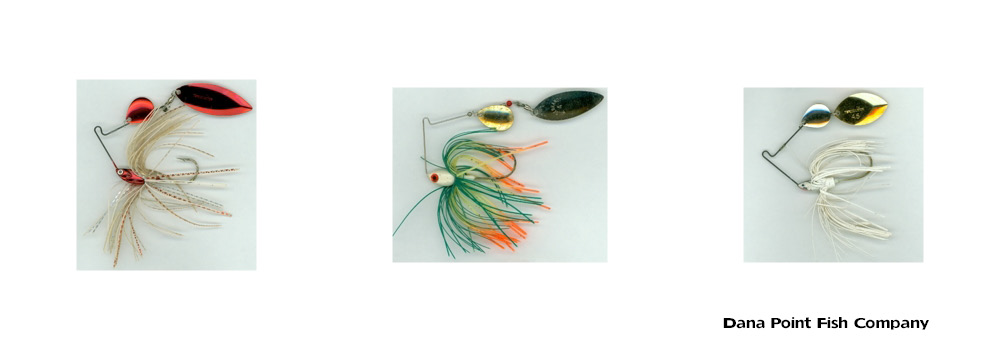Fishing for spotted sand bass, Paralabrax maculatofasciatus, throughout Southern California harbors and bays can be one of the most enjoyable types of fishing available to California anglers. Better known as the spotted bay bass, “spotties” are one of the most pugnacious species available to light line anglers.
These fish are easily accessible to fisherman from the shore, float tube, kayak, or small craft all year round.
Some of the more popular southern California spotted bay bass hot spots are San Diego Bay, Mission Bay, Newport Harbor, and Huntington Harbor. There are many other harbors, bays, and lagoons that offer fantastic fishing for spotted bay bass, including both sides of the Baja peninsula.
Due to their similar habits regarding structure, habitat, and forage, many techniques that freshwater bass anglers have developed cross over exceptionally well to our harbors and bays for the spotted bay bass. One technique that is quickly gaining in popularity due to effectiveness and versatility is throwing a spinnerbait, or “blade”. 
Basically a sideways “v” shaped piece of wire with a single or multiple blades on the top arm and a metal head and hook molded onto the bottom arm, with a skirt attached right behind the head of the bait, the spinnerbait does not look like anything a fish would want to eat when you look at it out of the water.
Spinnerbaits are available in a wide variety of blade options. The most popular are willow leaf, Indiana, and Colorado blades. Willow leaf blades are the longest and most narrow (picture the shape of a willow leaf, go figure!) style of blade. Indiana blades are slightly shorter and rounder, while Colorado blades are almost round. The advantage to a narrow blade is the ability of the bait to run deeper and come through cover (think eel grass) due to less resistance from the blades turning, while the rounder blades produce more vibration and keep the bait higher in the water column. The most common rigs have either one or two willow leaf or Colorado blades, a single willow or Colorado, or a combination of a Colorado or Indiana blade ahead of a willow leaf. Popular sizes vary from ¼ ounce to ¾ ounce in the bays, although there are many applications for the bigger 1 ounce and heavier baits. The bigger baits are often deadly for the open ocean cousins of the spotty, the calico and barred sand bass. Skirt and blade colors vary as much as your imagination will let them.
One advantage to throwing spinnerbaits in the bays is that you can cover a lot of water quickly to locate fish. Known as a reaction bait, a fast moving spinnerbait passing by an aggressive bass hiding out in or around some type of structure typically doesn’t give the bass time to make a decision. It’s either pounce immediately or miss out on an easy meal. This type of fishing doesn’t give the bass a chance to wonder why the heck he’s about to swallow a funky looking hunk of spinning metal. When bass are in a feeding mode this can often trigger aggressive strikes and locate concentrations of good fish. You can cover a lot of eel grass or docks in a short time and eliminate unproductive water, enabling you to really fish the water holding the most and highest quality fish.
Let the fish tell you the speed of the retrieve that they want. Often times it’s just a steady retrieve with a 5:1 or 6:1 gear ratio reel, but sometimes they will whack it when it’s burned back to the boat. While a swimbait can also be used in the same fashion, sometimes the flash of the blades and particularly the vibration of the blades will draw more strikes from bass buried in the grass. The vibration of the blades can be the key, as the bass hidden deep in the weedscan really feel the turning blades on his lateral line even if he can’t see it. It will tick him off as it approaches his private little junk yard!
Another good way to fish the spinnerbait, particularly in the winter or when the bass are not responding to a reaction bait, is slow rolling the bait across the bottom. This technique can be deadly around isolated structure or over sand. To slow roll the spinnerbait, cast it out past your target and let it sink on a slack line. Watch your line for any sign of a bite on the drop. Once the bait has settled to the bottom, slowly crank the bait back so you can barely feel the blades turning, keeping contact with the bottom. Many times a curious bass will take notice of the bait kicking up silt and crush it, mistaking it for a tasty crustacean or wounded baitfish. Don’t hesitate to fish the blades vertically around dock pilings as well. Often time the bass will hide on the shady side of a piling waiting for the current to bring him a meal. Make it easy for him and drop it on his head! Stealth is important around the pilings, as you have to be close by to properly drop the bait vertically. Pitching or casting the bait to the pilling tends to cause the bait to arc back towards the angler, even on a slack line. Ease up to the piling and drop it straight down.
A great feature that makes the spinnerbait a real spotted bass weapon is the ability to bring it through the thickest cover without hanging up. Although you will get eel grass hung on the bait if you bring it through the thickest grass, it will still rip through with ease, often generating a strike when ripped free. One of the best techniques around the grass beds is just ticking the bait over the top of the grass. While other reaction baits like cranks or jerkbaits love to hang on the grass, the blade will come through like a champ.
Personally, my favorite blade options when fishing for spotties is usually a double willow or a Colorado/ willow combo. The willow leaf blades get down quicker, particularly in faster current, and also come through cover better. Silver, gold, or combinations of the two colors are my favorites. I like to use silver blades in brighter light and clearer water, or when matching a baitfish pattern, and gold blades in lower light or dirtier water, or when trying to match a crustacean pattern. To be honest with you, blade color is not that important to me, particularly when looking for a reaction bite.
Experiment to see what works best for you. As for skirt colors, I tend to keep it simple. White, white/chartreuse, or white/silver are my favorite colors. Take a walk through the aisles of a fresh water bass fishing shop and you’ll find that they are the most readily available. Whether or not the spotties like them the best is anybody’s guess, but I’ve just grown up throwing them and I have confidence in those colors. I also use fire tiger (orange/green/yellow) often in salt water, and it produces great. Again, the possibilities are endless and finding what works best for you is the most important thing in building confidence and becoming a better angler.
When selecting a spinnerbait, one thing to take into account is the construction of the wire. Although they typically run a few dollars more then baits with stainless steel wire, titanium wire baits can be a real advantage when fishing the spots. Titanium has been used for several years when building spinnerbaits due to the fact that the wire is flexible and has little memory. Oftentimes stainless steel wire bait will become bent and not run properly, where as the titanium wire will not become bent. While this is a great feature when fishing for freshwater bass, it becomes even more important in the bay.
One thing you will find out about spotties is that they strike very hard, but even more so they roll like crazy when hooked. When they start to roll, this can easily bend and fatigue stainless steel bait, eventually snapping it. So while the titanium baits, such as those made by Terminator, may cost $7.00 to $10.00 a piece, they will last much longer and are definitely worth the extra cash.
So now you have an idea about the spinnerbaits and how to throw them. But what is the best tackle to use? Most guys are comfortable throwing them on medium light to medium heavy bait casting set ups, although spinning tackle can also be used, particularly with the lighter baits. I usually throw them on 8 or 10 pound monofilament, sometimes going up to 12 pound if the structure is really unforgiving. You don’t have to go really heavy in the bays, but there are always variables that may make it smart to upsize your tackle. Freshwater bait casting reels, either round like the Shimano Calcutta 100 or 150 or low profile reels like the Shimano Curado are perfect for the spotties. Rods can vary a lot, I prefer a fast to extra fast tapered graphite rod from 6 ½ to 7 feet long. I like 7 feet over 6 ½, but some people prefer a 5 ½ foot pistol grip rod for throwing them in close to the really heavy cover (usually in freshwater). Like the baits, experiment until you find the tackle that you are most comfortable with and works the best for your style of fishing.
One thing that is very important, rinse your tackle lightly with fresh water when you are done fishing in the salt. Don’t use a high pressure hose to blast the salt into your reels, just a gentle rinsing works best. Service your reels and change your line often. Any tackle that is not taken care of will quickly feel the adverse effects of saltwater, but it will last as long as you want it to if properly taken care of.
One last thing I would like to mention, and this is important, is pay attention to the tides and learn how they effect your local water. Tide means current and current means food moving in and out the area. Fish will relate to structure depending on the direction and speed of the current. Generally, a large tide swing that moves a lot of water produces more action then a mild swing with little current. Bass will usually position themselves facing into the current, and usually on the down current side of the structure. Use this to your advantage when approaching and covering structure. Spend as much time as you can on the water.
There is no better way to learn a new technique or learn more about the fish you are pursuing than being on the water and experiencing it. Although the limit on spotted bay bass is ten 12” fish, I release all the spotties I catch. Their population is limited as they only reside and reproduce in the few local bays, and they are a slow growing fish. If you do decide to keep some for dinner, please do so in moderation and abide by all of the California DFG’s regulations. Although wardens are few and far between in California, the most likely spot to find them is in the harbors.
Respect your catch and do it justice on the plate if you do decide to take it home.

